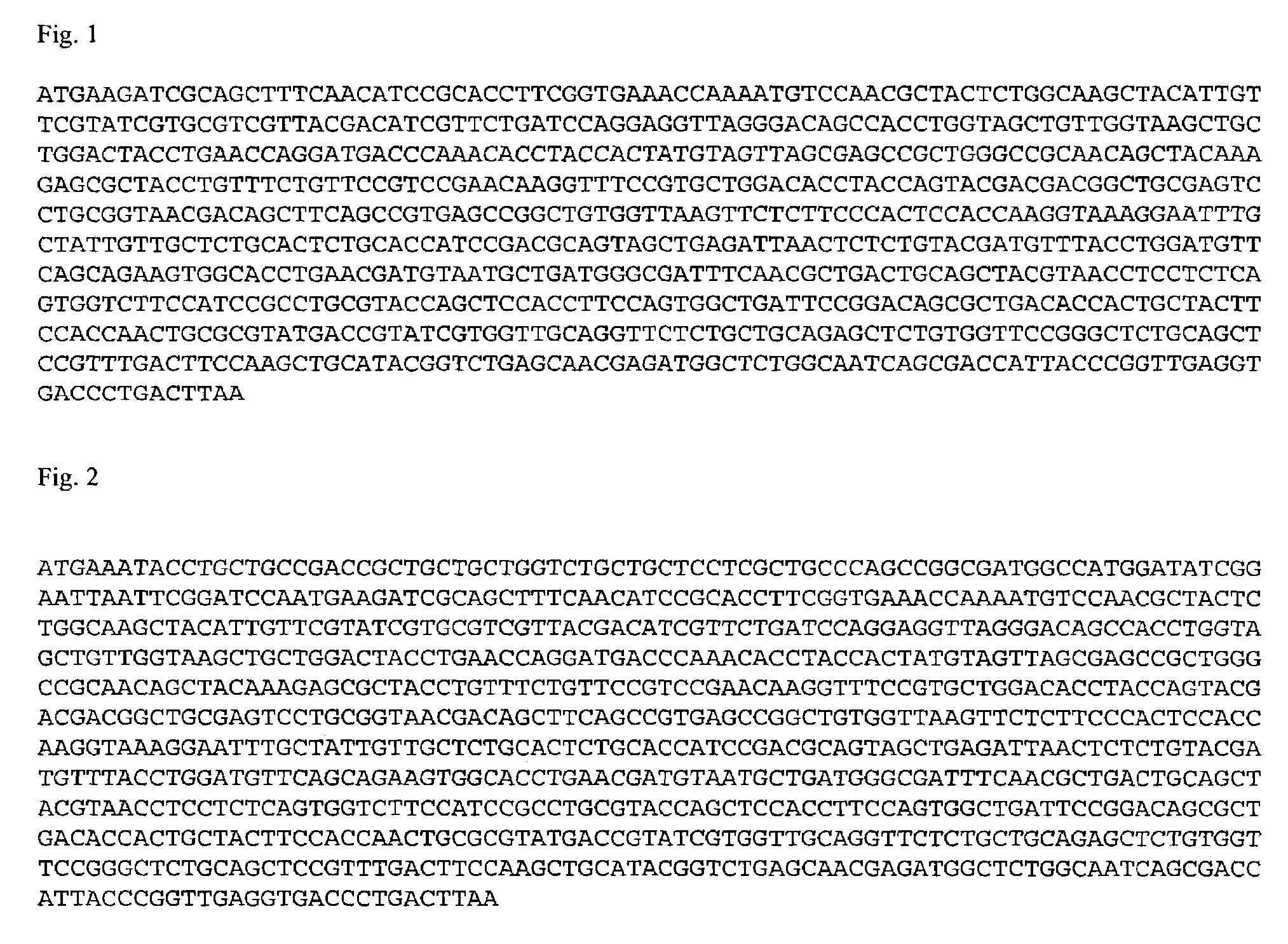Compositions and methods of using a synthetic Dnase I
- Summary
- Abstract
- Description
- Claims
- Application Information
AI Technical Summary
Benefits of technology
Problems solved by technology
Method used
Image
Examples
example 1
[0066]Expression of a Synthetic Bovine DNase I in E. coli. DNase I is an extremely toxic protein in E. coli. Inasmuch as this enzyme readily degrades dsDNA, active DNase I in the cytoplasm will cleave bacterial chromosomal DNA and kill the cell. In fact, an effective concentration of DNase I for clearing DNA contamination in advance of RT-PCR (˜2.5 nM) is approximately the same as that of a single DNase I molecule in an E. coli cell (assuming a cell volume of ˜1 fL). As a result, non-conventional strategies must be considered to successfully express this protein in reasonably high yield (>5 mg / L).
[0067]The coding portion of the gene for the synthetic bovine DNase I (sbDNase I) was created by assembling oligodeoxynucleotides that were synthesized de novo (FIG. 1). For common molecular biology and protein expression manipulations, procedures were performed as described in Molecular Cloning: A Laboratory Manual (Cold Spring Harbor Press) or Current Protocols in Molecular Biology (J. Wi...
example 2
[0082]Purification of sbDNase I from E. coli. The chromatographic strategy used to purify sbDNase I was based in part by that described by Chen et al. (Protein Science 2002; 11:659–668). Binding of sbDNase I to an anion exchange resin is mediated by its calcium binding properties. In addition to having several weak calcium binding sites, sbDNase I has two strong binding sites that bind with a micromolar Kd. A steric shift to binding free calcium and subsequent conformational change is likely to cause DNase to elute at low calcium concentrations (reportedly 7 mM), although the sbDNase I protein described herein elutes at a higher calcium concentration. Soluble sbDNase I collected from induced BL21(DE3) culture fluid was concentrated and dialyzed, in their case, by an ultrafiltration cell and purified by anion exchange. The sbDNase I activity was loaded onto the column in low ionic strength buffer (20 mM Tris pH 7.5), and eluted using a shallow CaCl2 gradient (0–15 mM).
[0083]The sbDNa...
example 3
[0085]Expression of sbDNase I in P. pastoris. The sbDNase I gene was cloned into the pPICZαA expression vector (Invitrogen), which is a shuttle vector containing the Zeocin resistance marker and yeast alpha-mating factor secretion signal sequence. The following primers were designed using NotI and XhoI restriction sites for insertion into the pPicZalpha plasmid:
[0086]
sbDNase I sequence XhoI L K I A A F N IATCCGCTCGAGAAGAGACTGAAGATCGCAGCTTTCAACATC(SEQ ID NO.: 13)pPICZsbDNase-Forward NotI StopT L T V E VATAAGAATGCGGCCGCTTAAGTCAGGGTCACCTCAACCG(SEQ ID NO.: 14)pPICZsbDNase-Reverse
[0087]PAGE-purified primers were used to PCR amplify an ˜800 bp fragment from pET-22b_sbDNase I. This ˜800 bp fragment (˜700 ng) was gel-purified, and digested with 50 U Not 1 and 20 U Xho I overnight. The pPicZαA vector (1.2 ug) was similarly digested. Both double-digested samples were then gel purified. FIGS. 3A and 3B show the nucleic and amino acid ...
PUM
| Property | Measurement | Unit |
|---|---|---|
| Fraction | aaaaa | aaaaa |
| Density | aaaaa | aaaaa |
| Density | aaaaa | aaaaa |
Abstract
Description
Claims
Application Information
 Login to View More
Login to View More - R&D
- Intellectual Property
- Life Sciences
- Materials
- Tech Scout
- Unparalleled Data Quality
- Higher Quality Content
- 60% Fewer Hallucinations
Browse by: Latest US Patents, China's latest patents, Technical Efficacy Thesaurus, Application Domain, Technology Topic, Popular Technical Reports.
© 2025 PatSnap. All rights reserved.Legal|Privacy policy|Modern Slavery Act Transparency Statement|Sitemap|About US| Contact US: help@patsnap.com



